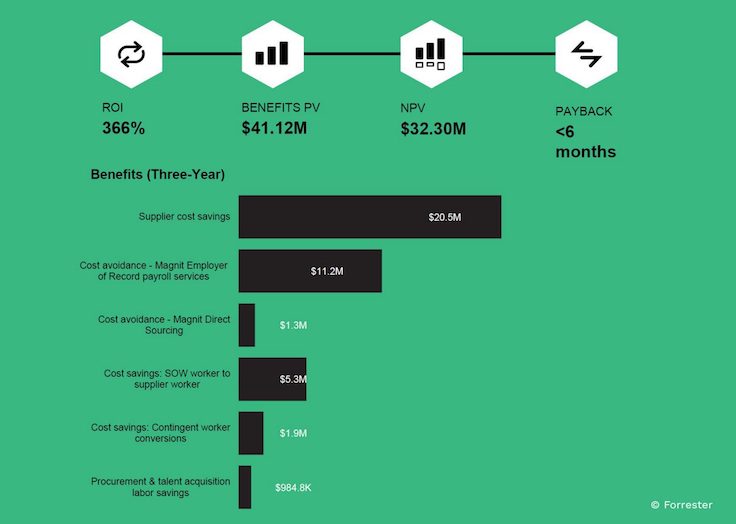Maximize Your Contingent Workforce ROI: Forrester Consulting TEI Study
Magnit January 17 2023

With the combination of current labor demand shifts and labor supply issues, there is a greater need than ever to have a contingent labor program that is versatile, cost-effective and full-service. Yet organizations face multiple challenges in optimizing their extended workforce, including inefficient talent acquisition processes, a lack of market intelligence and benchmarking data, contractor misclassification risk, limited visibility into workforce data, and more.
To help organizations better understand how an Integrated Workforce Management Platform can help businesses overcome these challenges, Magnit commissioned Forrester Consulting to conduct a Total Economic Impact™ study. The 2023 study examines the potential return on investment (ROI) enterprises may realize by deploying the Magnit Platform.
As part of its research on the benefits, costs and risks associated with this investment, Forrester Consulting interviewed seven representatives with experience using Magnit Platform. For the purposes of this study, Forrester aggregated the interviewees’ experiences and combined the results into a single composite organization that is a global company leveraging 1,000 contingent workers per year.
Driving Massive ROI with an Integrated Workforce Management Platform
Deploying Magnit Platform for contingent workforce management results in significant financial and organizational benefits for the composite organization. Specifically, the representative interviews and financial analysis found that a composite organization could expect to realize a 366% return on investment over three years, adding up to a net present value (NPV) of $32.3 million over that same period. These benefits are spread across six categories:
- Supplier cost savings
- Cost avoidance – Magnit Employer of Record payroll services
- Cost avoidance – Magnit Direct Sourcing
- Cost savings: SOW worker to supplier worker
- Cost savings: Contingent worker conversions
- Procurement & talent acquisition labor savings
In this post, we’ll provide a high-level overview of these six areas and the benefits organizations experience when implementing Magnit’s Integrated Workforce Management Platform.

Generating Supplier Cost Savings
The composite organization was previously at a reasonable maturity level with use of internal resources and workforce Managed Service Providers (MSPs) for contingent worker acquisition and management. Transitioning to Magnit’s Vendor Management System (VMS), using Magnit as a vendor-neutral MSP, and utilizing Magnit Total Talent Intelligence (including real-time dashboards and labor-market data and analytics) and Magnit Strategic Advisory leads to significant savings of $20.5 million over three years through right-pricing workers, having proper supplier selection, and receiving various discounts. (Related reading: “6 Signs Your Company Needs a VMS.”)
Shifting Workers to Employer of Record Payroll Services
As the contingent workforce grows, balancing pay competitiveness, cost optimization and talent quality becomes increasingly critical. The composite organization successfully sources new contingent workers from internally connected sources and transitions supplier-sourced contingent workers to Magnit Employer of Record payroll services program. According to Forrester Consulting, this leads to additional savings of $11.2 million over three years.
Sourcing Contingent Workers Directly via Magnit Direct Sourcing
When deployed strategically, direct sourcing enables organizations to “control their own destiny” by leveraging their brand to attract, curate and engage talent communities. The composite organization reduces contingent costs by $1.3 million over three years by utilizing Magnit Direct Sourcing to source and engage workers directly. Use of Magnit Employer of Record payroll services program further increases payroll services utilization when workers would historically be sourced through staffing suppliers. (Download the white paper: “Understanding Today’s Holistic Approach to Direct Sourcing.”)
Reducing SOW Workers to Contingent Workers
Billions of dollars are spent on services procurement annually, yet many organizations don’t accurately capture and track their Statement of Work (SOW) spend. By identifying workers under SOWs that could be sourced as contingent workers, the composite organization saves significant costs per worker, which translates to $5.3 million over three years according to Forrester Consulting’s analysis.
Converting Contingent Workers to Full-Time Employees
Transitioning high-quality contingent workers to full-time employees offers companies a host of benefits, but many businesses lack the visibility into workforce data that’s needed to effectively implement this strategy. The composite organization reduces costs to the tune of $1.9 million over three years by expanding a common practice of hiring contingent workers by gaining better visibility to contingent-worker data such as length of service.
Optimizing Talent Acquisition
From hiring and onboarding workers to improving DE&I and a positive worker experience, architecting and managing a best-in-class contingent labor program can be challenging. Magnit provides the composite organization with labor savings of nearly $1 million within the talent-acquisition and procurement organizations, transitioning some workload to Magnit. Furthermore, Magnit takes on workload associated with a shift in priorities such as diversity expansion.
Unquantified Benefits
Beyond the six categories covered in this post, Forrester Consulting’s study found more than a dozen benefits that provide value but were not quantified. Download the full study for much more on how Magnit’s Integrated Workforce Management Platform enables organizations to successfully source, track and manage their extended workforce.
If you’re interested in learning more about how Magnit is helping organizations implement winning contingent workforce programs globally, please contact a Magnit representative at info@magnitglobal.com.
Disclaimer: The content in this blog post is for informational purposes only and cannot be construed as specific legal advice or as a substitute for legal advice. The blog post reflects the opinion of Magnit and is not to be construed as legal solutions and positions. Contact an attorney for specific advice and guidance for specific issues or questions.